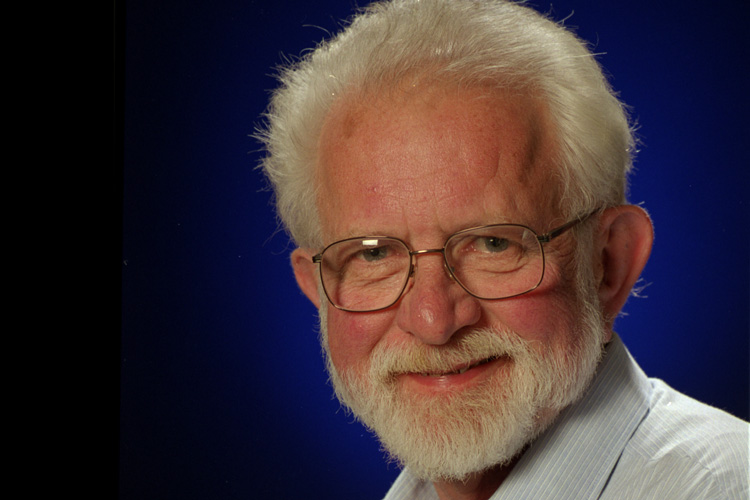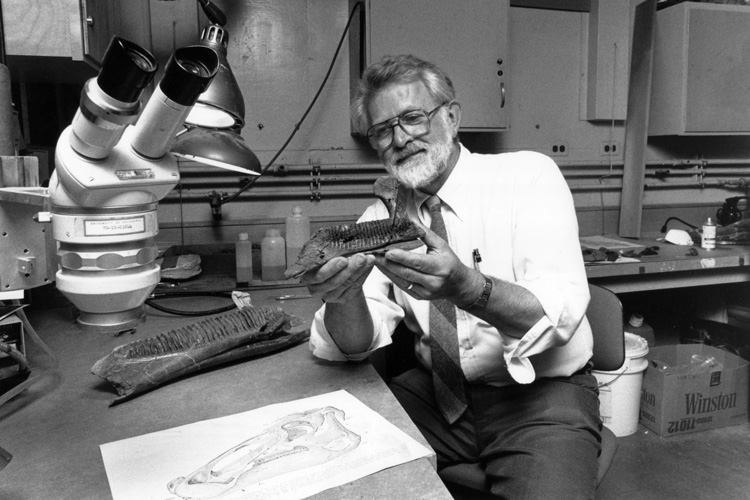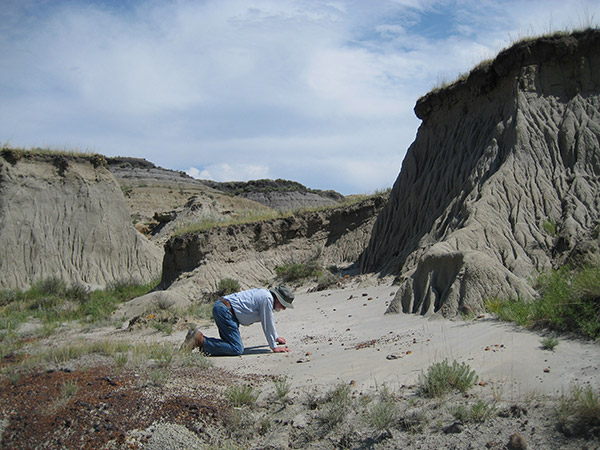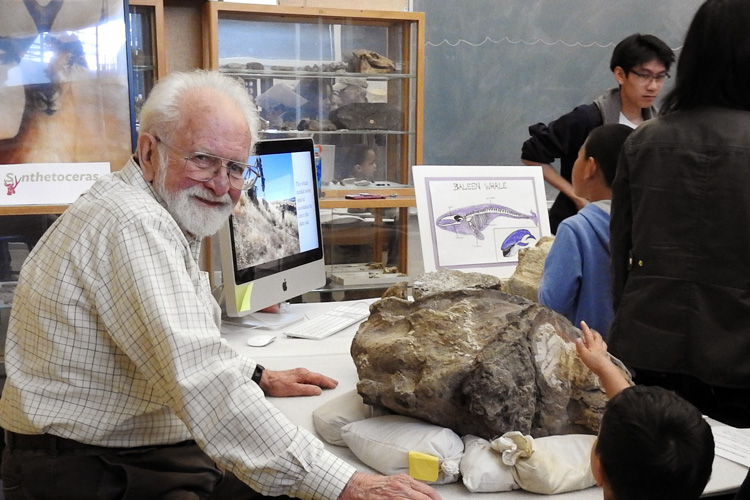William Clemens, expert on fossil mammals, dies at 88
The UC Berkeley Professor Emeritus was an internationally known specialist on the mammals that lived before and after the mass extinction 66 million years ago
December 1, 2020

William Clemens, professor emeritus of integrative biology, died Nov. 17, 2020, at the age of 88.
Bill Clemens had been excavating fossils in eastern Montana’s Hell Creek Formation for more than 10 years, focusing primarily on the small mammals that scurried around the feet of dinosaurs and other Mesozoic Era creatures, when, in 1980, Walter and Luis Alvarez at the University of California, Berkeley, proposed that the dinosaurs and most of life on Earth were wiped out at the end of the Mesozoic by an asteroid or comet impact.
As a paleontologist who had unearthed myriad fossils from before and after the putative impact 66 million years ago, Clemens knew the story wasn’t that simple. Dinosaur fossils in the Hell Creek Formation, where he and his team dug every summer, began to peter out hundreds of thousands of years before the end of the Mesozoic.
And while the large dinosaurs like T. rex and Triceratops disappeared at the end of the Cretaceous — the so-called Cretaceous-Paleogene or K-Pg boundary, which is defined as the end of the Mesozoic — other dinosaurs, which evolved into modern birds, survived and began to flourish. Similarly, many small mammals that Clemens focused on, as well as reptiles and amphibians, weathered the cataclysm and quickly evolved to repopulate the continents.
Clemens, who died peacefully of metastatic cancer at his home in Berkeley on Nov. 17 at the age of 88, became one of the most persuasive voices against the impact hypothesis. He represented many biologists and paleontologists who, seeing continual turnover of life in the fossil record, challenged the catastrophism of physicists like Luis Alvarez, geologists like his son, Walter, and, increasingly, the public, which found the impact hypothesis very compelling. While the debate between the two camps became, at times, rancorous, Clemens continued to calmly press for a more nuanced view: that other global changes — a cooling climate and extensive volcanic eruptions in what is modern day India among them — contributed to Earth’s last mass extinction.

Paleontologist William Clemens and geologist Walter Alvarez often debated the impact hypothesis for the last mass extinction, which Alvarez first proposed with his father, Luis, in 1980. (UCMP photo by Mark Goodwin, 2001)
“You have to remember that this asteroid hypothesis was not based on any evidence of paleontology or climate change. It was a great, daring hypothesis that was partly right. But some wanted it to be all right, and the evidence didn’t say this,” said vertebrate paleontologist Kevin Padian, a UC Berkeley professor emeritus of integrative biology and curator at the UC Museum of Paleontology (UCMP) who took Clemens’s side in the debate. “It was the evidence of the lizards and snakes and different kinds of mammals and amphibians, all the things that Bill and his team had been studying for at least a decade, collecting thousands and thousands of specimens before the asteroid hypothesis came along, that showed a gradual changeover in these faunas across the Cretaceous boundary.”
In the ensuing 40 years, evidence confirmed that the impact really did happen and put a more precise date on the event, but debate persists. It’s still not clear whether other global environmental changes contributed to the mass extinction, or whether these changes proved irrelevant when the impact brought down the final curtain.
“Bill’s work has been central to the vitality of this debate,” said Charles Marshall, UCMP director and professor of integrative biology, who also stressed the critical importance of field-based research programs like those of Clemens and his students in advancing our understanding of how life has evolved.
No matter how the scientific debate resolves, because the Hell Creek Formation is one of few places in the world where fossils can be found on both sides of the K-Pg boundary, the fossil collections Clemens made there in 40 years of excavation were critical to ground-truthing the impact hypothesis, said Patricia Holroyd, a vertebrate paleontologist and UCMP senior museum scientist.
“If Bill had not gone out there in 1970 and started developing those collections, we would not have that snapshot (of life at the end of the Cretaceous); we wouldn’t have been able to ask these questions about extinction and survival when the asteroid data came out about 10 years later,” she said.
“Through decades of brute-force work, he and his students laid the foundation for the empirical record, especially for mammals, in the later Cretaceous and across into the Cenozoic, to answer the questions to what happened at the end of the Cretaceous,” Marshall added.
Marsupials and more
Over his 60-year career, Clemens published on fossils throughout the Mesozoic and early Paleogene, covering more than 150 million years of evolution, making him one of the premiere authorities in the world on the origin, diversification and geographical spread of the first mammaliaformes: living mammal groups, including humans, as well as mammalian precursors that eventually became extinct.

William Clemens with fossils of a hadrosaur, a plant-eating, duck-billed dinosaur, discovered in Alaska’s North Slope. Clemens argued that, if dinosaurs could live in the Arctic, they could have lived through a sudden cooling caused by a comet or asteroid impact. (UC Berkeley photo by Ben Ailes, 1987)
“Bill was one of the greatest fossil mammal experts of the past century,” Holroyd said.
Among Clemens’s earliest interests were fossils at the Triassic-Jurassic boundary, a period 200 million years ago when the first mammal-like creatures arose and diversified. Their descendants radiated through the Mesozoic and include all living groups of mammals. These groups, then and now, are mainly known from the Northern Hemisphere, and Clemens spent several years in Europe on Guggenheim and Humboldt Foundation fellowships describing their morphology and evolution.
He shifted his focus in 1970 to the K-Pg boundary, making particularly important contributions to the understanding of marsupials, which radiated in North America before disappearing, only to flourish in South America and, eventually, Australia. He also pioneered our understanding of the early evolution of placental mammals, publishing on the earliest representatives of primates, hoofed mammals and insectivorous lineages.
Thanks to Clemens and many teams of students and researchers who helped prospect and quarry fossils in the Hell Creek and Fort Union Formations, he was able to develop a detailed, stratigraphically controlled paleontological dataset and geologic framework for addressing questions of the timing and patterns of faunal change across the K-Pg boundary. He and his team painstakingly excavated and screenwashed tons of sedimentary rock, using the waters of the nearby Fort Peck reservoir, in search of tiny bones and teeth.

Like all paleontologists, Bill Clemens spent a lot of time close to the ground in search of fossils. Clemens specialized in small mammals, which often left behind only fossilized teeth and broken microfossils. (Undated photo)
Holroyd noted that, though Clemens did not always credit himself with the fossils he and his team collected and brought to the UCMP, she estimates that together they collected in excess of 50,000 specimens and about one-fifth of the UCMP collection, many of them microfossils.
According to Holroyd, Clemens once remarked that when he “started his dissertation, all of the world’s Mesozoic mammals would fit in a matchbox. He really developed the field of Mesozoic mammalian paleontology.”
Clemens mentored nearly two dozen Ph.D. students and was a major influence on dozens of others at UC Berkeley and around the globe, many of whom accompanied him into the field in search of fossils.
Berkeley born and bred
William Alvin Clemens Jr. was born May 15, 1932, in Berkeley, California. His father, Vincent, was an electrical engineer with Westinghouse Electric who worked during World War II at the nearby Kaiser Shipyards. His mother, Estella, had taught high school chemistry and home economics in Illinois. Clemens credited his mother with introducing him to fossils at the Clemens family’s old homestead in Goshen Hole, Wyoming, where fossils spilled out of the hillsides. Clemens’s father admitted to gathering fossil horse teeth to sell to collectors passing through.

Even in retirement, Clemens showed up each year on Cal Day – UC Berkeley’s annual open house – to introduce children and adults to the world of fossils in the UC Museum of Paleontology. (UC Berkeley photo by Patricia Holroyd, 2018)
After graduating from Berkeley High School, Clemens enrolled at UC Berkeley and began working in the Museum of Paleontology after taking a paleontology course from then-UCMP Director Ruben Stirton. In an oral history Clemens recorded in 2015, he said that his work with the late UC Berkeley paleontologist Don Savage cemented his interest in pursuing paleontology as a career and mammalian paleontology, specifically. As an undergraduate, in 1953, he spent the summer with Savage visiting fossil sites around the West.
Upon obtaining his B.S. in 1954, he joined the U.S. Army and was stationed in Germany, where he was joined by his new wife, Dorothy “Dot” Thelen Clemens, also a Berkeley native and a 1955 UC Berkeley alumna. After two years, he returned to UC Berkeley as a graduate student, working under Savage, and spent the next four years excavating and cataloging small mammal fossils from the Lance Formation in eastern Wyoming in an attempt to understand the diversity of mammals at the end of the Cretaceous. He produced a three-volume compendium of these fossils for his thesis in 1960.
Clemens was immediately offered a position at the University of Kansas, where he also served as curator of fossil vertebrates at the Museum of Natural History. He returned to UC Berkeley in 1967 as an associate professor of paleontology and was promoted to full professor in 1971. He chaired the department and directed the UCMP from 1987 to 1989. The paleontology department eventually merged with others to form the Department of Integrative Biology. He retired as an emeritus professor of integrative biology in 2002, but continued to conduct research on his fossil collections until this fall. He focused on the evolution of mammals after the mass extinction.
Clemens served as president of the Society of Vertebrate Paleontology, as well as a trustee and, later, the president of the board of trustees of the California Academy of Sciences. He was given the Romer-Simpson Medal and the Joseph T. Gregory Award by the Society of Vertebrate Paleontology, two of its highest honors. He was also a fellow of the Geological Society of America.
Clemens’s wife, Dorothy, died in 2015. He is survived by four children — Catherine, Elisabeth, Diane and William — and seven grandchildren. Donations in his memory may be made to the UCMP.